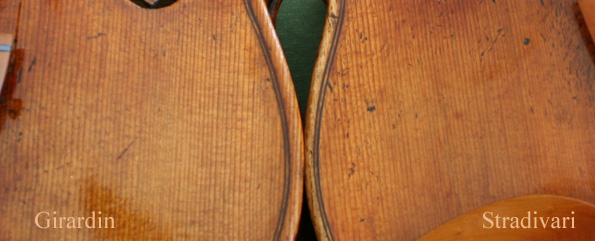Varnish
On the left my varnish of Cremona, on the right the original made by Antonio Stradivari 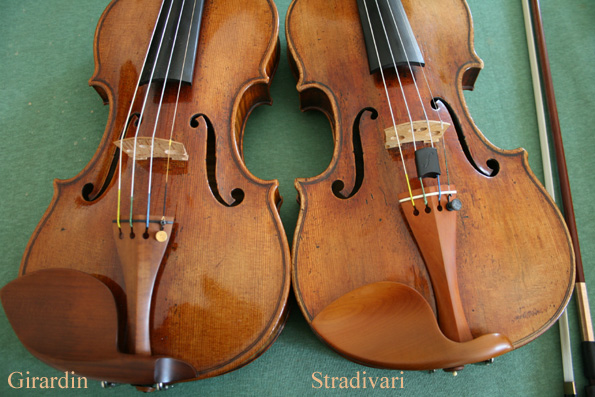
Detail of the same picture
Italian varnish has always fascinated violinmakers and musicians, It still makes us dream and constitutes a permanent debate between those questioned by the subject and those who have resolved it…
Many years_of research, practice and experiments lead to the following finding:
whether yellow, golden, red or deep brown thick or thin, ancient varnishes are all beautiful and almost all extraordinary.
Why?
Doubtless because the varnish’s secret is not in the unique, lost or secret recipe of a specific varnish but rather in the forgotten art of the applying process, in a “know how” rather than in abstract knowledge. Varnishing an instrument is similar to culinary art. It is not so much the recipe that leads to a successful meal, but rather the way the cook will make use of it in a masterly fashion only transmitted orally from master to disciple.
Discovery of the "secret of Stradivarius" in 2009
A German-French team of 12 experts (chemists, violinmakers, restorers) examined attentively five violins of Antonio Stradivari which are preserved in the "Cité de la Musique" of Paris. They published their study in the prestigious German scientific review for chemistry "Angewandte Chemie" (international edition).
http://onlinelibrary.wiley.com/doi/10.1002/anie.200905131/abstract
Formula
According to this study the secret of Antonio Stradivari's varnish was uncovered. This varnish so often described as the only reason of the superiority of Stradivari consists of two fine layers. The first one is a layer based on oil, followed by a second one, which is a mixture of oil and pine resin into which Stradivarius incorporated various pigments used in painting, in order to vary the color. And that is all!
Here are some links related to this event.
http://sciences.blogs.liberation.fr/home/2009/12/soleil-perce-le-secret-du-stradivarius.html
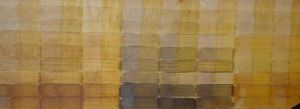
Shader
What do ancients say?
In old varnish treatises from 1550, 1564 and 1713, I chose 7 recipes that I deliver here in their original form. (For english speaking people, there is a word to word translation).
Alexis le Piémontais
(Secret des Arts, 1550)
Formula no 1 (spirit varnish)
Take benjoin and grind it then put into bottle and pour over it enough eau-de-vie, so much as it passes the benjoin by two or three fingers, and leave it so for two or three days, then add, for half bottle brandy, five or six lightly minted or entire safran strands. This done, you will flow it and with a brush will varnish any golden thing you want, which will become gleaming by drying during several years.
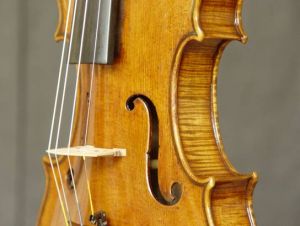
Example of golden varnish put on the “Kardos”- violin made in 2003
Formula no 2 (varnish without thinner)
Another that will dry promptly. Take male incense and writing varnish namely sandarac which is juniper gum. Use as much as you want. Reduce it to powder as fine as you can and incorporate together. Take then Venetian turpentine, and put it in a non greasy bottle and undo it. Then putt inside the said powders, little by little, incorporating them without making it too tender but just right; and so warm, flow it through muslin. And when you want to use, warm it and spread very fine, and it will make your work very gleaming and will dry rapidly and well.
Formula no 3 (oil varnish)
Linseed oil (3 pounds) that you will have boil and, to know whether it is enough, throw inside a hen’s feather, and if it burns forthwith it will be cooked. Then take:
Sandarac…………………… (8 ounces)
Aloès hépatique…………. (4 ounces)
Powder them beforehand, then put into boiling oil and mix until liquefied. pass through muslin and you will loose the useless half being too thick and not good for use. To use it, let it warm in the sun.
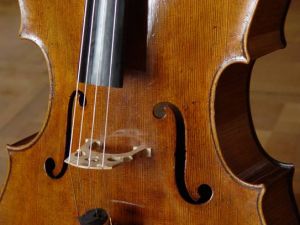
Example of oil varnish put on the “Saiz” cello made in 2003
Fioravanti.
(Miroir universel des Arts et des Sciences, 1564)
Formula no 4 (spirit varnish)
Benjoin, sandarac and mastic: powder them well, add eau-de-vie. Let the mixture dissolve on a low flame or in the sun. Gums will dissolve easily and form a very brilliant varnish that with dry promptly.
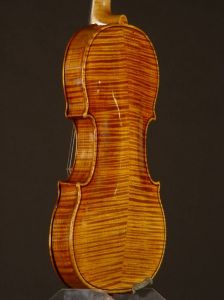
Example of brilliant varnish put on a violin made in 2012 (private collection)
The R. P. Bonanni
(Traité des vernis, 1713)
Formula no 5 (oil varnish)
A maronite priest, Donato Aldoense, sent the following recipe to Father Bonanni:
Linseed oil………..………….1 ounce
Mastic of Persia……………1 ounce 112 to be melted.
After which one adds oil until some white foam appears. When one wants to use it to color some objects, one mixes it with powdered colors.
This varnish becomes very hard.
Formula no 6 (oil varnish)
M. Garnier, the Queen of Poland’s physician transmitted to Reverend Bonanni the following recipe for a varnish which is pliant and supple under hammer’s stroke.
Have the Venetian turpentine boiling, and then add as much heavy of powdered copal. Have it boil a quarter of an hour, stirring it well with a stick then put in cooked oil. Have it mix together over a flame, then let the varnish become as liquid as desired with aspic or turpentine essence. It has to be used a little warm.
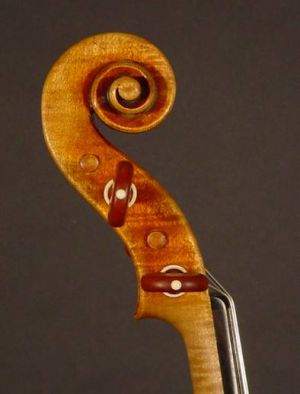
Example of supple varnish put on the “Raspo” violin made in 2003
Formula no 7 (Porefiller)
Finally, Father Bonanni says that before applying varnish on wood, one must cover it with the following varnish to impregnate it.
Aspic oil……………....…… 8 ounces
powdered sandarac…… 5 ounces
The whole being well incorporated over a flame, one coats the piece to be varnished with it all warm, and when it is dry, one puts varnish on.
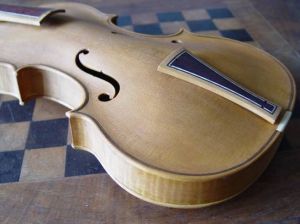
Example of porefiller put on the “Dalla Vecchia” baroque violin made in 2004
Simplicity
However harmless they may seem, these recipes seem to be animated by an inner life that makes them interact with each other. All very simple, as confirmed by the discovery in 2009 of Antonio Stradivari's varnish, they give the varnished object an incomparable beauty. The varnisher is the link between this simplicity and its effectiveness. Thanks to his multiple talents as an interpreter, both of wood with its moods and of varnish and its specific reactions, he plays the role of conductor. Wood indicates the way forward if it is understood and the varnisher chooses the appropriate recipe based on his experience with varnishes. This knowledge of both wood and varnishes is fundamental. All this with sound as the goal.
Conclusion
Whether you make an alcohol varnish or an oil varnish, whether you want it glossy or satin, whether it is hard or soft, the important thing is to find a total harmony between this varnish and the wood. The sound, like a lighthouse or a compass, guides us throughout and remains the final goal. Then, the intrinsic beauty will reveal itself.
Personal Considerations on
The Color of the Varnish and the Backs of Stradivarius
The varnish.
Antonio Stradivari's seven cellos, exhibited in Cremona in 2004, showed, beyond their great visual and cultural interest, a great variety of varnish colours. Each instrument had a different color. The exhibition book clearly shows this, even if the colours reproduced by the photos are not entirely accurate.
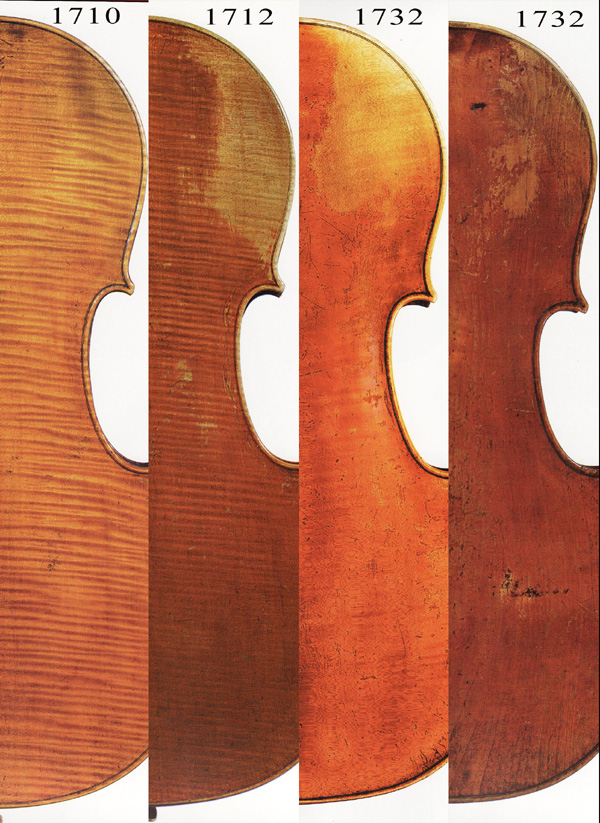
Excerpts from the exhibition book I made this photomontage which testifies to this great variety of color. Unfortunately, the ex-Batta Stradivarius of 17??, which was not exhibited, is missing. It would have brought the testimony of an unusually thick varnish and especially of an impressive purple red.
This observation of variety of color is particularly interesting, especially when it is the same luthier. One could have imagined that the varnishes would be different from one luthier to another, but not to this extent in the same luthier.
In this image we can see that the two middle backgrounds on the right are from the same year (1732). This is very interesting. This leads us to believe that it would therefore be a deliberate choice of Stradivarius to vary the colour according to his willingness and not a significant varnish of different periods of his life. However, we know that he used fewer varied varnishes at the beginning of his career than he did afterwards. At first its varnish was not very colourful, or even transparent and varied slightly around the amber yellow, exactly like the cello of 1710 (on the left of the photo). In the 1690s he introduced red (see his violin called the "Tuscan" of 1690) and then a few years later, in his period called the "golden", he used all shades. They range from transparent to dark brown and all shades of yellow, orange and red.
The Backs.
On closer inspection, it can be seen that not only the varnish could be of different colours, but also the sub-base. Between the undersides of the two cellos dated 1732, one is yellow and the other red brown. Stradivarius therefore easily switched from light yellow (1732) to light brown (1710) or green-grey (1712) to red brown (1732) according to his desires or according to the wishes of his customers, or even according to the wood used, which he perhaps left free. With its different undersides and varnishes, it can be said that it mastered a vast palette of all possible tones.
This great variety of colour, especially of the subsoil, is typical of the 18th century. It became considerably more uniform during the 19th century and all looked the same by the 20th. Pure technique, uniformity and symmetry characterize the past century. The 21st marks the return to diversity, to variety, to the philosophy of "never the same thing twice". I would like to call this change of direction "the rebirth of lutherie".
Currently a profusion of very high level luthiers offer a top-of-the-range personal lutherie in almost every country in the world. The prices of these instruments have only been rising for the past twenty years or so. The musicians understood perfectly where their interests lay. Currently they are investing heavily in this type of instrument to access instruments of incomparable quality and at prices that are still unrivalled compared to an old one.
Examples of two Backs
While visiting a collector, owner of two very beautiful stradivari, to get to know and show him at the same time my last two violins, I was surprised by the similarity of my two sub-bases with these prestigious instruments. I had fun putting them next to each other and photographing them under the same conditions. These are not copies, of course. It is a pure coincidence that my two sub-bases are so close to the two Stradivarius that I saw for the first time.
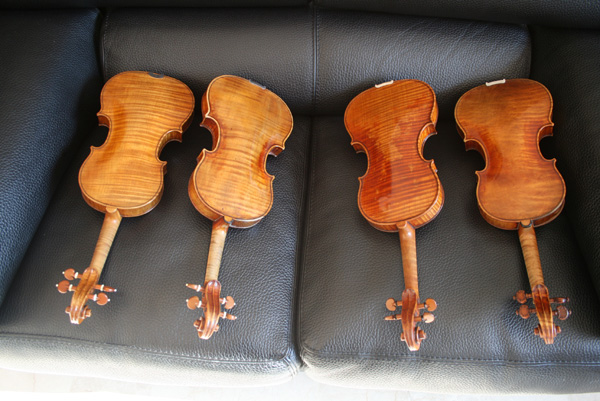
On this picture we can see a big difference between the two dark and the two light violins. Light also exaggerates this difference.
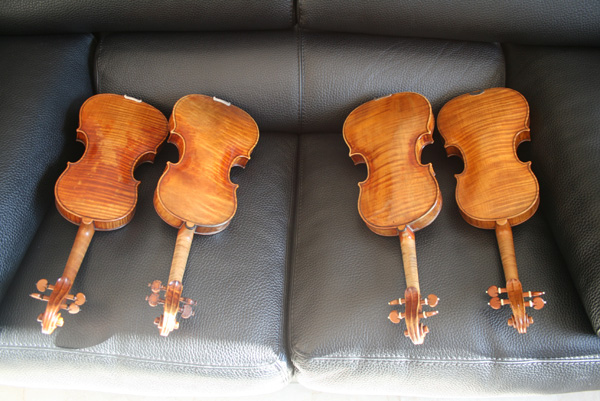
On this one, I deliberately switched the two groups by putting the two dark violins on the left of the picture and the light ones on the right. This time the light attenuates the difference and they all seem to be the same color. In reality they are obviously different, but perhaps not as much as in the upper picture.
Currently I love to obtain on my own instruments all kinds of variations of grounds and varnishes. The difference comes more from the type of wood than from the recipe to be used according to the desired sound. As wood is a "living material that only does as it pleases", I increasingly let wood react in its own way. I guess it's part of life that's not linear or uniform, and that's fine with me. Either we accept her irregularities or we force her like a bonsai. For me it's a question of philosophy. Having personally constrained him for about twenty years, I am currently leaving much more room for difference, for particularism. It is also the pendulum of history, sometimes to the right and sometimes to the left. As I said earlier in the 18th century, we were in variety in variety in uniformity in the 20th century, we are returning unstoppable to diversity.
p.s. on the bottom photo the two Stradivarius are in the center of the image and the two Girardin on the outside.
And in the picture above, did you guess which are the Stradivarius?
